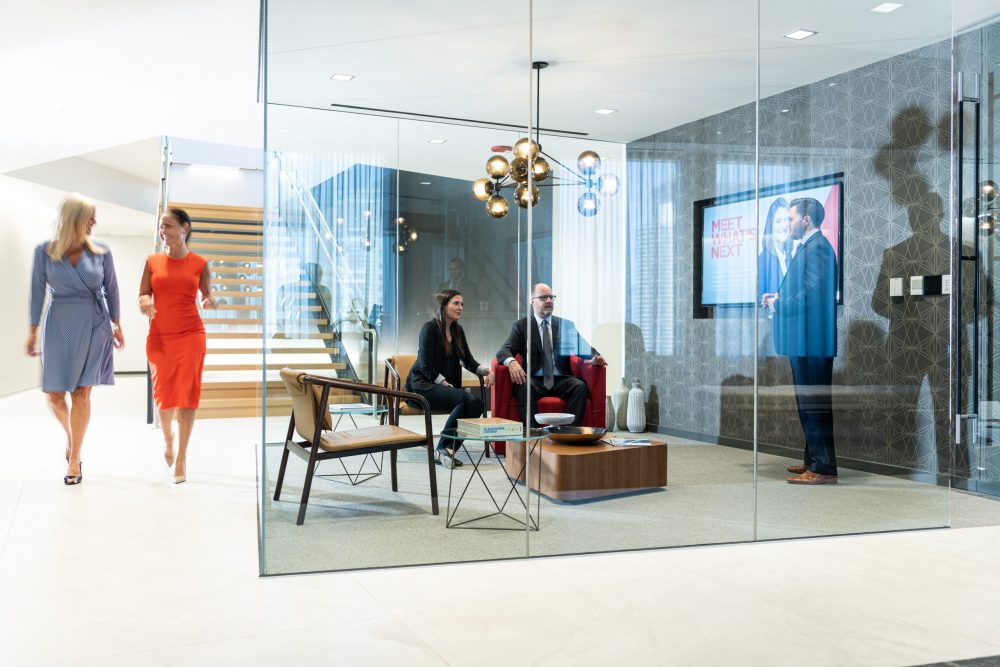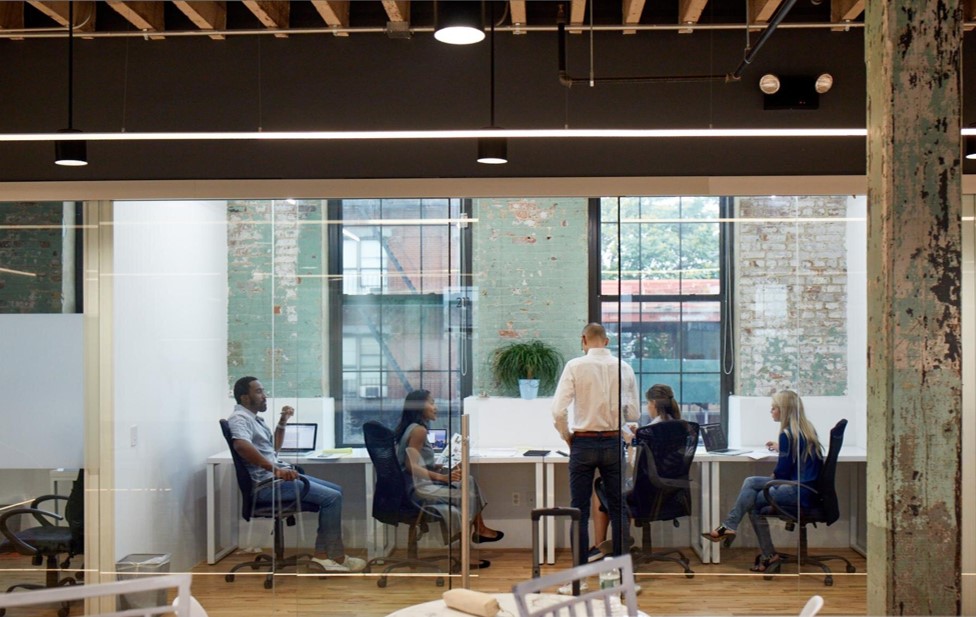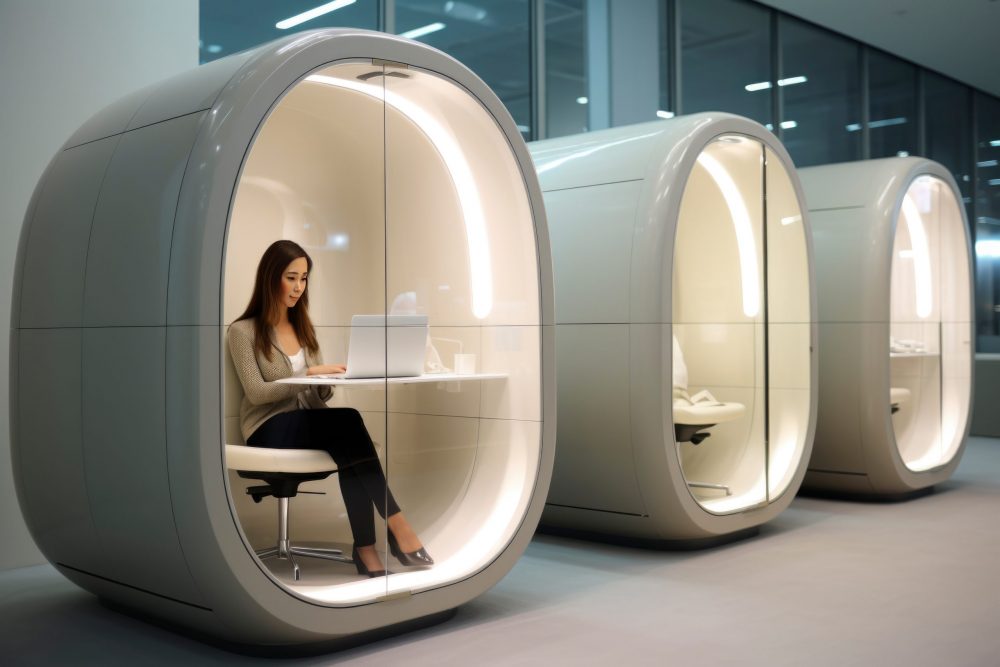After decades of optimizing for space, efficiency, and cost, the workplace industry is finally facing a reckoning: the true measure of success isn’t utilization or occupancy—it’s how people feel at work.
The Evolution of Workplace Models
For the past two decades, corporate real estate groups, architects, and designers have introduced an evolving series of workplace strategies: Open Plan, Activity-Based Working (ABW), Hot Desking, Hoteling, Hybrid Work, Flex Work, and Remote-First. These models have been primarily framed around space, efficiency, and technology – emphasizing how to optimize square footage, manage occupancy, or deploy digital tools.
While each approach moved the conversation forward, they consistently place the workspace at the center – not the people using it. Walk into client offices today, and conversations still revolve around attendance, desk ratios, and occupancy sensors, but rarely about how people feel in those spaces.

The Challenge
Despite decades of innovation, the real estate industry has done little to measure the human impact of these environments. Success is still too often defined by cost, utilization, or operational efficiency (e.g., lease costs, vacancy, service costs).
Furthermore, the workplace ecosystem remains siloed. Designers focus on space, service providers on operations, technology teams on tools and systems, and HR on policies and engagement. Each group has different contracts, KPIs, and priorities, rarely aligned with a shared measure of employee experience. This ultimately leaves organizations unsure whether they are creating a holistic, productive and engaging experience.
Recent Gallup data from their 2025, “State of the Global Workplace,” underscores the challenge. Only 21% of employees are engaged, with productivity losses from disengagement estimated at $438 billion annually. More tellingly, only about 60% of employees say their offices support collaboration and connection – the very purposes organizations cite as primary. The gap between aspiration and reality persists.
A Transformational Opportunity
Since the pandemic, work has undergone a transformational reset. Where, when, and how people work has shifted dramatically. Employee satisfaction levels are declining, and instances of burnout are increasingly prevalent. Employees are demanding more flexibility, while leaders are grappling with mandates, hybrid, and distributed models.
This disruption presents an opportunity to truly place people at the center of workplace strategy. Activity-Based Working (ABW) advanced beyond traditional desk-based models by offering employees a choice of settings tailored to different tasks—improving flexibility, productivity, and space efficiency. Yet, these environments often became standardized and transactional. Experience-Based Working (EBW) takes the next step—shifting from providing a variety of settings to curating a variety of experiences that foster purpose, connection, wellbeing, and performance.
As organizations prioritize experience-based workplace solutions, data-driven insights are crucial for evaluating and improving workforce engagement and experience. Companies increasingly rely on Cushman & Wakefield’s Experience per Square Foot™ (XSF), a leading tool recognized for providing precise, actionable, and data-driven insights into how workplace environments influence employee engagement and experience. The result is higher employee satisfaction, which ultimately leads to better business outcomes.

Reframing Strategy Around Experience
It’s time to move from space-based strategies to EBW. EBW begins by asking: What experience do people need to thrive at work? From there, placemaking, technology, and services are aligned to create environments that:
- Enable people to do their best work
- Strengthen wellbeing and work-life balance
- Inspire connection to culture and purpose
- Build engagement that drives business performance
New KPIs must reflect this shift: Workplace Experience, Wellbeing, Inspiration, Connection, and Ability to Thrive. These metrics extend beyond traditional engagement surveys, which often overlook the role of place.
Just as important, these KPIs should be shared across CRE, HR, IT, and the business. Everyone who shapes the workplace – from architects to service partners to tech vendors – must see how their work impacts the human experience. When CRE, HR, and IT come together around a shared purpose of helping people thrive, the collaboration is transformative.
Data from employee sentiment diagnostics reveals what matters most to workplace experience. Analysis of aggregate survey results by Cushman & Wakefield on workplace experience drivers across multiple organizations reveals that, of 40 potential workplace attributes, only 20-25% truly drive meaningful value. Half of those high-impact attributes perform well, while the other half represent pain points requiring attention.
The top five drivers of workplace experience include:
- Creating an energizing atmosphere through lighting, color, natural elements, and ergonomic furniture
- Reflecting company culture through design that visually and functionally supports organizational values
- Providing quiet spaces for focused, uninterrupted work
- Minimizing noise through enhanced acoustics and sound management
- Supporting private conversations with dedicated, sound-buffered spaces for calls
When employees are satisfied with these features, their average workplace experience score reaches 77%. When dissatisfied, the score drops to just 51%, a 26-point gap that underscores both the powerful influence of these features and the opportunity for targeted investment.
Experience-Based Working: A Natural Evolution
Experience-Based Working is not a radical break from the past – it is the natural evolution of ABW, hybrid, and flex models. Traditional Activity-Based Working centers on providing a variety of workplace settings aligned with different tasks – focus rooms, agile work rooms, collaboration spaces, and social hubs. While a step forward from rigid, one-size-fits-all offices, ABW often overlooks the reality that people approach the same activity in very different ways, shaped by their personal preferences, energy levels, and working styles.
EBW shifts the focus from tasks to people, prioritizing the overall workplace experience and ensuring that environments are flexible, inclusive, and adaptable to diverse needs. Instead of generic settings, EBW offers choreographed experiences that allow both individuals and teams to choose environments that best suit them – whether that means quiet, low-energy spaces or vibrant, high-energy spaces for the same task.
Crucially, EBW integrates all the disciplines that shape the workplace – architects, interior design, technology, facilities management, food service, reception, support teams, and policies – around a single purpose: creating environments where people can thrive and, in turn, enable stronger organizational performance.

Understanding How Workplace Drives Engagement & Wellbeing
As we shift focus to the people, it is important to evaluate how our workplaces and the workplace experience impact employee wellbeing. Data from aggregate Cushman & Wakefield survey results shows that while overall workplace experience has rebounded – up 9 points from 2023 to reach 65% in 2024 – wellbeing remains stubbornly low at 40%. Employees with high well-being are four times more likely to report that they can do their best work compared to peers with low well-being.
The workplace drivers of wellbeing differ somewhat from general experience drivers. The five features with the greatest impact on employee wellbeing include minimizing noise, reflecting company culture, supporting quiet work, offering social and active areas, and ensuring thermal comfort. Yet satisfaction with these critical features averages just 40%, highlighting a significant opportunity for improvement.
For example, a leading financial services company recently utilized XSF to enhance the employee experience while implementing a return-to-office mandate. Previous XSF data showed that companies implementing mandates found that employees experienced a 25% drop in employee satisfaction. To combat this drop, the company implemented a people pledge to enhance the workforce experience while simultaneously introducing a 3-day workweek mandate. By implementing XSF action recommendations, the company saw its workplace experience score improve by 7.5%. This demonstrated that focusing on experience can positively impact outcomes, even when implementing attendance requirements.
Putting EBW Into Practice
Operationalizing EBW requires moving from aspiration to execution. As analyzed in Cushman & Wakefield’s recent Reimagining Workplaces report, there are three proven actions distinguish organizations achieving measurable success:
- Strategic Alignment & Vision. Workplace change stalls without clear ownership and long-term vision. Unified governance structures bring together CRE, HR, IT, and business leadership around shared goals, codify best practices, and ensure that investments contribute to a coherent system. Setting a clear, outcome-driven vision transforms the office from a mandate into a meaningful destination. Elevating workplace strategy to a C-suite priority secures funding, governance, and consistency, positioning the workplace as a lever for competitive advantage.
- Experience-Centered Design & Integration. Legacy efficiency models emphasized tasks and space but overlooked people’s diverse needs and preferences. EBW reframes the workplace as an ecosystem of experiences—integrating space, policy, technology, and services to drive outcomes such as engagement, equity, collaboration, and culture. Employees experience the workplace as a whole, not in silos. True integration means every element—design, technology, services, amenities, and support—works together to deliver a unified, purposeful experience.
- Measurement, Learning, and Scaling. Utilization and attendance tell only part of the story. Leading organizations measure outcomes that matter – engagement, inclusion, wellbeing, cultural alignment, and productivity – alongside the workplace attributes that shape them. A test-and-learn culture allows leaders to pilot, measure, refine, and scale strategies, building trust with employees and accelerating adoption. Capturing and codifying best practices across teams and geographies ensures lessons are embedded and adapted locally, creating a cycle of continuous improvement.
The Path Forward
The shift from space-based to experience-based workplace strategy represents more than a design trend – it reflects a fundamental reorientation around what matters most. For decades, the industry has optimized for cost per square foot, utilization rates, and operational efficiency. These metrics have their place, but they cannot capture whether people feel energized, connected, and able to do their best work.
Experience-Based Working requires organizations to measure what matters – workplace experience, wellbeing, cultural connection, and performance – and align investments accordingly. This requires unified governance across CRE, HR, and IT, experience-centered design that integrates all workplace disciplines, and systematic measurement that enables continuous improvement.
With the data-driven tools like XSF and an experience-based mindset, companies can move beyond efficiency to create workplaces that are adaptive, human-centered, and performance-driven. EBW isn’t just another workplace strategy; it’s a philosophy. When we design and measure around people’s experiences, we unlock the full potential of both individuals and organizations.
The future of work will not be defined by attendance mandates or utilization metrics. It will be defined by whether organizations can create environments where people genuinely thrive – and whether leaders have the courage to measure, invest in, and prioritize what truly drives human and business performance.


